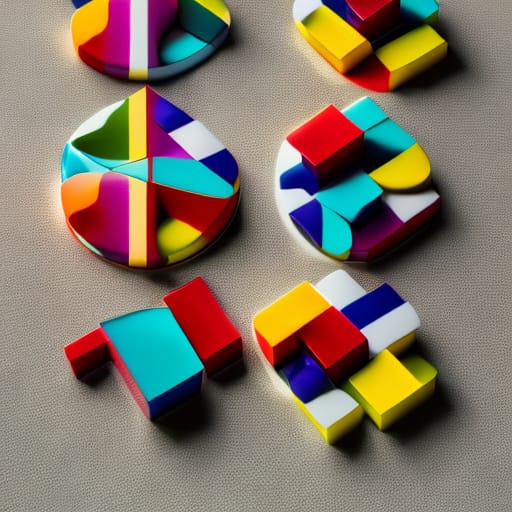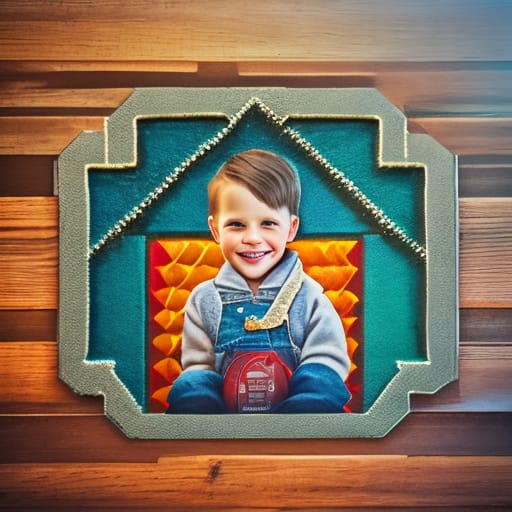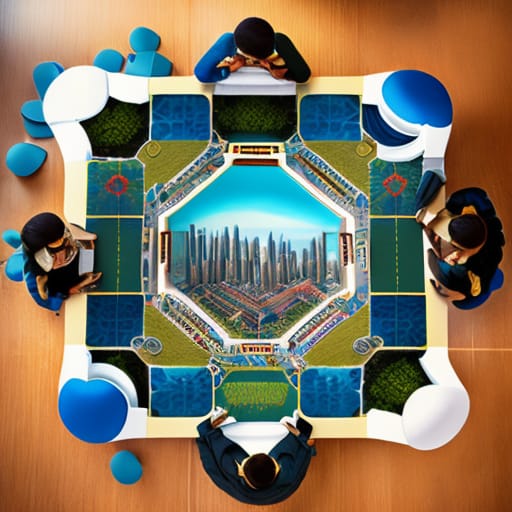Magnetic tiles are a popular educational toy that provide endless opportunities for open-ended play and learning. These colorful plastic tiles contain magnets, allowing children to connect them to build elaborate 2D and 3D structures and designs. As an engaging hands-on toy that sparks creativity and imagination, magnetic tiles promote important developmental skills in children through playful discovery and experimentation.
What Are Magnetic Tiles?
Magnetic tiles are interlocking building blocks or tiles that connect together via embedded magnets. They are made from durable plastic in a variety of shapes and colors. The most common shapes are squares and triangles, but some sets also contain specialized pieces like diamonds, pentagons, Stars of David, and more.
The tiles stick together through magnetic attraction, allowing children to build vertically and overhead without structures collapsing. This opens up immense possibilities for building detailed and intricate structures from children’s imaginations.
Unlike other building block sets that follow specific blueprints, magnetic tiles encourage open-ended creativity. Children can use them to free-form creations like buildings, vehicles, landscapes, mosaic artworks, marble runs, and more. Popular structures kids love to build include:
- Towers and skyscrapers
- Castles, forts, and bridges
- Zoos and farms with animals
- Garages and racetracks for cars
- Abstract sculptures and mosaics
Benefits of Magnetic Tiles for Children
Playing with magnetic tiles provides a wealth of developmental and educational benefits:
- Enhances STEM skills: Building intricate structures promotes early engineering, math, and spatial skills.
- Develops problem-solving: Construction challenges stretch creative thinking and reasoning.
- Improves motor skills: Manipulating small tiles aids hand-eye coordination and dexterity.
- Sparks imagination: Open-ended play builds storytelling and roleplaying skills.
- Teaches organizational skills: Sorting tiles by color, shape, etc. develops classification abilities.
- Introduces early math concepts: Counting, addition, subtraction, fractions, geometry.
- Builds social skills: Collaborating on structures teaches teamwork and communication.
- Boosts self-confidence: Successfully executing an idea/vision instills pride and self-assurance.
This winning blend of fun and enriching skills makes magnetic tiles one of the most versatile and educational toys on the market.
Top Magnetic Tile Brands
Several companies produce high-quality magnetic tile sets. The top brands known for their superior quality, durability, magnet strength and array of specialty pieces are:
- PicassoTiles
- Magna-Tiles
- Geomag
- Playmags
- Magformers
- KidKraft
| Brand | Price Range | Special Features |
|---|---|---|
| PicassoTiles | $30 – $120 | Vibrant colors, creative shapes beyond squares/triangles |
| Magna-Tiles | $25 – $150 | Clear lucite tiles reveal magnets, build 3D structures |
| Geomag | $25 – $100 | Unique magnetic joints for movement/mobility |
| Playmags | $40 – $100 | Colorful transparent pieces, great for backlighting |
| Magformers | $20 – $150 | Beginner STEM sets organized by theme/project |
| KidKraft | $30 – $70 | Bright chunky pieces perfect for toddlers |
The best magnetic tile set provides enough pieces for elaborate creations without being overwhelming. Look for around 100 tiles in a starter set. Popular addon packs include wheels, people, animals, and specialty vehicles for enhanced play possibilities.

Getting Started with Magnetic Tiles
Magnetic tiles are suitable for children ages 1.5+ years. With adult supervision, children under 3 can enjoy freeform sticking and sorting activities with large, chunky pieces. Around age 2-3, kids can follow simple building cards to construct trucks, towers, etc. Ages 4+ can create increasingly complex structures from their imagination without assistance.
We recommend following this sequence when introducing magnetic tiles:
- Free Exploration
- Use Pattern Cards
- Follow Building Ideas
- Invent Original Creations
To extend magnetic tile play:
- Incorporate sight words, math vocabulary, or letter/number tiles.
- Add toy cars and animals for make-believe roads, cities, habitats.
- View images of architecture around the world for building inspiration.
- Take stop-motion videos of magnetic tile constructions.
- Create marble runs by propping up tracks with tiles.
- Use magnetic tiles to teach symmetry and geometry.
The educational possibilities with magnetic tiles are truly endless!
Choosing the Best Magnetic Tiles Set
With countless magnetic tile products on the market, choose one tailored to your child’s age and skill level:
For toddlers (ages 1.5-3 years), opt for chunky pieces around 1.5 inches thick. Bright primary colors appeal most to tiny builders.
- KidKraft and Playmags offer oversized pieces even small hands can manipulate.
For preschoolers (ages 3-5 years), look for a 100+ piece set with smaller 1-inch tiles. Kid-friendly themes like zoo animals or cars capture their imagination.
For grade school (ages 5+ years), choose quality brands like PicassoTiles that offer intricate building challenges. Specialized pieces like shapes, pivots, and 3D connectors allow advanced structures.
Look for BPA-free plastic tiles made from durable ABS material preferred for toys. Strong embedded magnets should securely connect pieces without jamming fingers. Smooth tile edges prevent scratches.
With hundreds of magnetic tile products available, focus on reputable brands meeting safety and quality benchmarks ideal for your child’s age and interests. Thorough online reviews by real parents can provide helpful insight.
Creative Learning Activities with Magnetic Tiles
Beyond freeform building, magnetic tiles present unlimited possibilities for guided educational activities. They can be incorporated into classroom lesson plans, homeschooled curriculum, early intervention therapy programs, and more to reinforce skills.
Here are some creative magnetic tile project ideas to try:
Math Concepts
- Count and Add: Ask children to build a certain number of tile structures (ex: “Build me 5 garages”). Have them count out tiles needed and construct.
- 2D and 3D Shapes: Identify the 2D geometric shapes in the set. Use them to build cubes, pyramids, rectangular prisms.
- Symmetry and Patterns: Create artwork with symmetrical and repeating patterns.
- Fractions: Split structures into equal fractional parts. Remove 1⁄2, 1⁄3 pieces and describe.
- Measurement: Use a ruler or measuring tape to determine the height, length and width of structures. Compare sizes.
- Addition with Tile Numerals: Use numbered tiles to add and record number sentences.
- Marble Math Race: Create downhill tracks and have marbles race from start to finish positions representing different numbers.
Language Skills
- Sight Words: Label structures or tilescapes with written sight words, letters, sounds.
- Storytelling: Use magnetic people, animals, and buildings to tell interactive stories. Record with photos or videos.
- Descriptive Vocabulary: Enhance verbal skills by having kids describe their magnetic tile creations using spatial words like under/over, above/below, next to/beside, taller, longer, etc.
Thinking Skills
- Critical Thinking: Present a specific building challenge then have kids brainstorm solutions. Guide them through testing ideas.
- Problem Solving: Introduce problems into structures (earthquake knocks down tower, animals escape zoo) and have children troubleshoot fixes.
- Sequencing: Provide steps to construct structures in order like a pyramid, house, or bridge.
- Categorization: Ask children to sort tiles types by color, shape, size, function.
Keep it fun by letting kids lead these learning games based on their interests and skill levels. With magnetic tiles, developing new skills happens almost effortlessly through hands-on discovery!

The Art of Playing with Magnetic Tiles
More than a toy, magnetic tiles empower children to channel their creativity into mini architectural marvels and artworks. Famed architects like Frank Gehry cite playing with blocks and model building materials as sparking their interest in the profession. Open-ended magnetic tiles nourish this innate building passion in children.
With magnetic tiles offering endless play potential, don’t be surprised if your tiny Van Gogh spends hours perfecting colorful mosaic sculptures or futuristic cityscapes rivaling Dubai. The world is their oyster – with magnetic tiles letting their young imaginations run free. Be sure to proudly display your little one’s impressive magnetic masterpieces on the fridge when playtime wraps up!
Frequently Asked Questions
What age are magnetic tiles appropriate for?
Magnetic tiles are suitable for ages 12 months+ with proper supervision to prevent swallowing hazards. Around 12-18 months, babies can sort chunky pieces. By 18-24 months, toddlers can construct simple structures. More complex building happens around 3-4 years when fine motor skills develop. Sets with small pieces work best for ages 4+.
How do I clean magnetic tile pieces?
Most magnetic tile pieces are waterproof and can be washed with mild soap and water. Ensure tiles are completely dry before reconnecting to maintain maximum magnetism. Follow manufacturer guidelines for cleaning specialty pieces like magnetic people, animals, and vehicles.
What surface is best for building with magnetic tiles?
Magnetic tiles stick best to flat, smooth surfaces like finished wood tables or metal baking sheets. Avoid porous surfaces like carpet that reduce magnet strength. For tall structures, build on floor rather than wobbly table edges. Use a cookie sheet underneath to catch falling pieces.
Can I make DIY magnetic tiles?
While homemade magnetic tiles are possible using adhesive magnet strips, we don’t recommend it. Manufactured magnetic toys adhere to strict safety standards for magnet size/strength appropriate for children. Purchase quality premade magnetic tiles that indicate ages appropriate on packaging.
How do I organize and store magnetic tiles?
Start with a basic sort by color and shape. Clear plastic bins or divided boxes help kids easily access pieces. Specialty tiles like people, vehicles, and animals can go in separate small compartments or bags. Store larger structures intact by sliding plastic lids underneath creations overnight.
